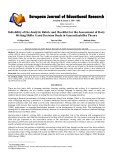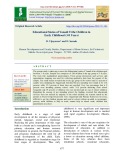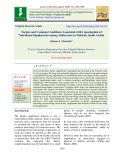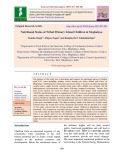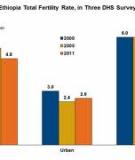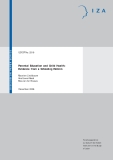
Attending primary school
-
The purpose of study is to examine the reliability of analytical rubrics and checklists developed for the assessment of story writing skills by means of generalizability theory. The study group consisted of 52 students attending the 5th grade at primary school and 20 raters in Mersin University.
 12p
12p  viarnault
viarnault
 25-04-2024
25-04-2024
 1
1
 1
1
 Download
Download
-
The present study is taken up to assess the Educational status of Yanadi tribe children aged between 3 -8 years. Sample size comprises of 250 children in the age group of 3-8 years. The tools like standardised questionnaire, Focus group discussions and services and opportunities mapping was used for collecting qualitative data from the parents of the sample. The study results revealed that in the age group of Pre-school only 13 percent of sample were attending the Anganwadi. Enrolled but not attending were found to be 21.6 percent, while 12.5 percent of them have not enrolled.
 6p
6p  angicungduoc5
angicungduoc5
 14-06-2020
14-06-2020
 11
11
 0
0
 Download
Download
-
In the last decades, dietary supplements consumption has increased in the Western world for all age groups. The long-term potentially dangerous effects related to an indiscriminate consumption of dietary supplements are still unknown and are becoming a matter of public health concern. Therefore, the aims of the present study were to explore the contribution of dietary supplements intake, and to evaluate awareness and knowledge about dietary supplements.
 11p
11p  nguathienthan4
nguathienthan4
 18-04-2020
18-04-2020
 19
19
 5
5
 Download
Download
-
The purpose of this study was to determine and compare the nutritional status of children aged 8-11 years attending primary school among two tribes (Khasi and Garo) of Meghalaya. Anthropometry method was used in the study. Two basic variables (height and weight) and a single derived variable (body mass index‐ BMI) were utilized. All the anthropometric measurements were taken following standard techniques. Twenty four hour recall method was used for dietary assessment. First degree mild malnutrition (40.89%) and third degree severe malnutrition (3.
 14p
14p  trinhthamhodang3
trinhthamhodang3
 12-02-2020
12-02-2020
 15
15
 1
1
 Download
Download
-
Ouandja Sudanese refugee camp has shown that 32% of children suffer from SAM. In addition, HIV rate prevalence (6.2%) is amongst the highest in the region and with a third of the population completely lacking access to clean water and sanitation facilities; preventable diseases are wreaking havoc amongst CAR’s vulnerable and conflict-affected populations. Only 51% of children get the opportunity to attend primary school, the figure is much lower in CAR’s conflict affected prefectures where the majority of schools are closed due to the ongoing instability.
 5p
5p  nhacnenzingme
nhacnenzingme
 23-03-2013
23-03-2013
 41
41
 3
3
 Download
Download
-
Rwanda’s population is predominantly rural, with more than four in five Rwandans living in rural areas. Fifteen percent of women and 17 percent of men live in urban areas. Overall, 68 percent of women and 69 percent of men have attended some primary school without having gone on to post-primary/vocational or secondary school. Only 21 percent of men have attended post-primary/vocational, secondary, or tertiary education and about 16 percent of women have done so. School experience in Rwanda is not universal; 16 percent of women and 10 percent of men have never attended school.
 68p
68p  nhamnhiqa
nhamnhiqa
 01-03-2013
01-03-2013
 46
46
 1
1
 Download
Download
-
Similarly, the overall net attendance ratio at the secondary level, that is, the percentage of the secondary school age population (11-15 years) attending secondary school, also increased from 22 percent to 47 percent during the same ten-year period (Figure 2.6). The results also indicate that the percentage increment in net attendance ratio for primary level as well as secondary level was higher for girls than boys. Despite such progress, more than half (53 percent) of children eligible for secondary level schooling were not attending school.
 76p
76p  thankinhphanliet
thankinhphanliet
 21-12-2012
21-12-2012
 52
52
 3
3
 Download
Download
-
It demands of us that we attend to the enormous unmet needs in child and adolescent mental health, that we recognize the paucity of services precisely where needs are greatest, and that we insist on action to remedy the treatment gap. Some 30 years ago, Julian Tudor Hart, a primary care physician practicing in a low income community in Wales, proposed an inverse care law. It reads: “The availability of good medical care varies inversely with the need for it in the populations served.” Nothing better illustrates this proposition than the data in this Atlas on how few child psychiatrists.
 31p
31p  le_minh_nha
le_minh_nha
 12-12-2012
12-12-2012
 44
44
 2
2
 Download
Download
CHỦ ĐỀ BẠN MUỐN TÌM








